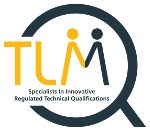Design and development of qualifications
RQF/CQFW Condition E1
1. These are the policies and procedures for designing and developing qualifications. Broadly, qualifications have aims and objectives provided in the qualifications handbooks and the design of the qualification is intended to ensure that these aims and objectives are met. (Condition E1.1b) More recently the DfE has required Awarding Organisations to publish purpose statements on their web sites for qualifications used in performance measures. These statements are available here. (Condition E1.1a) With respect to qualifications in the Entry level to Level 3 range, used by younger learners there is a common purpose in ensuring progression routes to higher level learning are kept open either in directly related subjects (Condition E1.2a) or in other subjects where, for example, digital literacy is important (Condition E1.2b). This is relevant to both academic, vocational and mixed learning. As an example, the TLM "substantial vocational qualification" (SVQ) in Managing IT Systems at Level 2, while targeted specifically on a workplace role in systems management (Condition E1.2e) and therefore employment in managing computer systems running GNU/Linux operating systems, (Condition E1.2d) it would also contribute suitable background knowledge, understanding and skills for further study in a range of disciplines related to digital technologies from Computer Science to Electronic Engineering. This means that these qualifications are in addition preparing learners to progress to a qualification in another subject area, (Condition E1.2b) It will also make anyone much more self-sufficient in any generic use of computers whether at home or at work.
2. In most cases, TLM qualifications form family groups with progression routes to enable learners to improve their competence over time and to motivate learning throughout a course. (Condition E1.1b) There is ample evidence that having a goal is motivating and coursework assessment that is directly related to achieving the qualification keeps the mind focused on the goal in day to day work. The qualification design strategy is to use this to promote tighter engagement and therefore raised standards over time. The benefit to learners is further strengthened by making the learning process as far as possible directly related to the assessment process and this also ensures valid assessment ie the assessment is assessing the learning it is intended to assess. What matters is a fair judgment that the learner has achieved the learning outcome, that the evidence supports the assessment criteria and that the assessment criteria are a fair indication that the learning outcome has been achieved. Methods that enable increasingly accurate self-assessment and peer review maximise opportunities to foster learning skills that will transfer to other contexts preparing learners for a changing world and a more rational approach to decision making. Clearly any self-assessment must be reliably verified by an independent assessor to ensure that it is accurate and truly representative of what the learner knows, understands and can do. In a technological age where change occurs quickly attitudes and process are equally important. Adaptability to change is important across all learning sectors but particularly related to occupations where digital technologies dominate practice. In any particular qualification the qualification proposal will identify the specific benefits to learners that it supports in addition to more generic contributions to the learning process (Condition E1.2) but the generic attitudinal development to learning is an important consideration for lifelong learning. The amygdala is as important as the pre-frontal cortex and TLM qualifications are designed to enable development of both.
3. TLM account managers are in continual dialogue with users of its qualifications. The demand for a new qualification normally arise from one or more of four key methods.
- Third party approaches to develop qualifications to support a specific curriculum development.
- Demand from users of existing qualifications for a new version to reduce bureaucracy and enable teachers to spend more time on teaching and less on administration.
- Demand from users to reduce costs.
- Changes due to government actions that fundamentally change curriculum priorities.
TLM will only embark on developing a new qualification where the demand shows a clear commercial potential for recouping development costs and sustaining operational costs in line with its risk based approach. The demand is greater than development capacity so there is a queue and it is prioritised according to risk, the fit with the general company vision and the commercial potential. In most cases, this will mean a need for potential for thousands of learners rather than tens or hundreds although it has to be recognised that the lead in time for take up can be several years, particularly with new innovation. Demand is further backed by a learning rationale provided in the qualification purpose statement making the benefit to learners clear. This is in the context of the overall design rational associated with TLM's INGOT brand. In the last analysis support from users will be the defining factor since without it there will be no commercial basis for development. TLM will provide estimates of the number of likely candidates on the Regulatory IT system and provides evidence of numbers several times per year as required. (Conditions E1.3, 1.4, 1.5)
4. All TLM qualifications posted to the Register of regulated qualifications will conform to the require title conventions. (Condition E2.1)
They will include:

